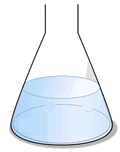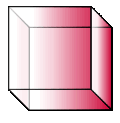Standard level
Gases, involved in chemical reactions show simple ratios between gas volumes. This makes dealing with gaseous reactions very simple in terms of calculations.
Syllabus ref: S1.4.6Structure 1.4.6 - Avogadro’s law states that equal volumes of all gases measured under the same conditions of temperature and pressure contain equal numbers of molecules.
- Solve problems involving the mole ratio of reactants and/or products and the volume of gases.
Guidance
Tools and links
- Structure 1.5 - Avogadro’s law applies to ideal gases.
- Under what conditions might the behaviour of a real gas deviate most from an ideal gas?

Gay Lussac's law
In 1808 the Freanch chemist Gay Lussac investigating the reactions of gases came to the conclusion that when gases combine chemically they do so in volumes that have a simple ratio to one another, and to any gaseous product, provided that all gases are measured at the same temperature and pressure. This became known as Gay Lussac's law.
For example, in the reaction between hydrogen and oxygen making water:



|
hydrogen + oxygen →
water
2H2 + O2 → 2H2O |
The volume of hydrogen needed for complete reaction is always double the volume of oxygen, provided the temperature and pressure of the two gases are the same.
Avogadro's hypothesis
Extending Gay Lussac's work in 1811, Avogadro suggested that "equal volumes of all gases contain equal number of molecules (the gases being measured at the same temperature and pressure). This became known as Avogadro's hypothesis or Avogadro's law.
This means that in the reaction:
N2 + 3H2 → 2NH3
For a given volume of nitrogen, three times the volume of hydrogen is needed for complete reaction. The volume of nitrogen contains a certain number of molecules and there are three times as many molecules in the volume of hydrogen.
|
N2
|
+
|
3H2
|
→
|
2NH3
|
|
1 molecule
|
+
|
3 molecules
|
→
|
2 molecules
|
|
1 volume
|
+
|
3 volumes
|
→
|
2 volumes
|
Avogadro's hypothesis allows us to substitute the coefficients of any balanced gaseous equation for volumes of gas, for example:
Example: Find the volume of hydrogen required to react completely with 200 cm3 of nitrogen according to the equation:
N2 + 3H2 → 2NH3
The equation tells us that 1 volume of nitrogen reactrs completely with 3 volumes of hydrogen:
Therefore volume of hydrogen = 3 x volume of nitrogen
Therefore volume of hydrogen = 3 x 200 cm3 = 600 cm3
Example:
Using the equation:
N2 + 3H2 → 2NH3
if 100 cm3 of nitrogen was used (this is now equivalent to 1 'volume') it would need 3 times as much hydrogen for complete reaction i.e. 3 volumes = 300 cm3.
The reaction would produce 2 volumes of ammonia i.e. 2 x 100 cm3 = 200 cm3
Worked examples
Q146-01 In the reaction between sulfur dioxide and oxygen forming sulfur(VI) oxide, the gases are passed over a hot vanadium pentoxide catalyst acording to the equation:2SO2 + O2 → 2SO3
Calculate the volume of oxygen needed to react fully with 200 cm3 of sulfur dioxide.Answer
|
The equation shows that sulfur dioxide reacts with oxygen in a 2:1 ratio Therefore 2 volumes of sulfur dioxide react with 1 volume of oxygen Thus for complete reaction 200 cm3 of sulfur dioxide needs 100 cm3 of oxygen |
Q146-02 What volume of carbon dioxide will be formed from the complete combustion of 200 cm3 methane?
Answer|
Methane burns according to the equation: CH4 + 2O2 → CO2 + 2H2O 1 volume of methane produces 1 volume of carbon dioxide Therefore 200cm3 methane produces 200cm3 of carbon dioxide |
Q146-03 What volume of oxygen will be required to completely oxidise 200 cm3 of ammonia according to the equation:
4NH3 + 5O2 → 4NO + 6H2O
Answer|
From the equation 4 volumes of ammonia requires 5 volumes of oxygen Therefore 200 cm3 of ammonia requires 200 x 5/4 volumes of oxygen = 250 cm3 oxygen |
Q146-04 What will be the final volume of gas when 300 cm3 ethene reacts with 300 cm3 oxygen at 400ºC?
Answer|
Equation for the reaction: C2H4 + 3O2 → 2CO2 + 2H2O Inspection of the equation shows that 1 volume of ethene requires 3 volumes of oxygen. In the question there is insufficient oxygen to react with all the ethene, i.e. the oxygen is the limiting reagent and only 100 cm3 of ethene can react. Therefore from the equation 1 volume of ethene reacts with 3 volumes of oxygen to produce 2 volumes of carbon dioxide and 2 volumes of steam (at this temperature) So 100 cm3 of ethene reacts with 3 x 100 cm3 of oxygen to produce 200 cm3 of carbon dioxide and 200cm3 of steam Initial volume of gases = 300 cm3 + 300 cm3 Final volume of gases = 200 cm3(CO2) + 200 cm3(H2O) + 200 cm3 (unreacted methane) = 600 cm3 of gas mixture |
Q146-05 What will be the final volume of the gas mixture, when 100cm3 propane reacts with 600 cm3 oxygen at 400ºC?
Answer|
Equation for the reaction: C3H8 + 5O2 → 3CO2 + 4H2O Inspection of the equation shows that 1 volume of propane requires 5 volumes of oxygen. In the question there is insufficient propane to react with all of the oxygen, i.e. the propane is the limiting reagent and only 500 cm3 of oxygen can react. Therefore from the equation 1 volume of propane reacts with 5 volumes of oxygen to produce 3 volumes of carbon dioxide and 4 volumes of steam (at this temperature) So 100 cm3 of propane reacts with 5 x 100cm3 of oxygen to produce 300cm3 of carbon dioxide and 400 cm3 of steam Initial volume of gases = 100 cm3 + 600 cm3 = 700 cm3 Final volume of gases = 300cm3(CO2) + 400cm3 (H2O) + 100cm3 (unreacted oxygen) = 800 cm3 of gas mixture |
Q146-06 When 100 cm3 of ethene is burned in excess oxygen, calculate the volume of carbon dioxide produced (all gas volumes measured at STP)
Answer|
Equation for the reaction: C2H4 + 3O2 → 2CO2 + 2H2O 1 volume of ethene makes 2 volumes of CO2 100cm3 of ethene = 100/22700 moles = 4.46 x 10-3 moles this makes 2 x 4.46 x 10-3 moles of carbon dioxide = 8.93 x 10-3 moles This is equivalent to 8.93 x 10-3 x 22700 = 200cm3 Note: the final answer demonstrates Gay Lussac's law of combining gas volumes - moles are proportional to gas volumes |
Q146-07 Calculate the volume of oxygen required to react with excess carbon monoxide, to produce 500 cm3 of carbon dioxide gas.
Answer|
The equation for the reaction: 2CO + O2 → 2CO2 Thus, 2 volumes of carbon monoxide react with 1 volume of oxygen to produce 2 volumes of carbon dioxide. If 500 cm3 of carbon dioxide gas are required then 2 volumes = 500 cm3 1 volume of oxygen is required = 1 x 500/2 = 250cm3 of oxygen |
Q146-08 In the combusion of methanal, 100 cm3 of methanal reacted with 200 cm3 of oxygen. Calculate the composition of the gas mixture produced, if all measurements were taken at STP.
Answer
|
Equation for the reaction: HCHO + O2 → CO2 + H2O Thus, 1 volume of methanal reacts with 1 volume of oxygen in a complete reaction. 100 cm3 of methanal will react with only 100 cm3 of of oxygen leaving 100 cm3 of oxygen unused. The final composition of the gas mixture = 100 cm3 of oxygen + 100 cm3 of carbon dioxide (water is a liquid at STP) |
Q146-09 At 200ºC carbon disulfide vapour reacts with oxygen according to the equation:
CS2 + 3O2 → CO2 + 2SO2
Calculate the final composition of the gas mixture produced when 1.2 dm3 of carbon disulfide vapour reacts with 1.2 dm3 of oxygen gas
Answer|
From the equation: 1 volume of carbon disulfide reacts completely with 3 volumes of oxygen In this case the oxygen is the limiting reagent and only 1.2/3 dm3 = 400 cm3 of the carbon disulfide can react (leaving 800 cm3 of the carbon disulfide unreacted) 400 cm3 of carbon disulfide (equivalent to 1 volume in the equation) produces 400 cm3 of carbon dioxide and 2 x 400 cm3 = 800 cm3 of sulfur dioxide. The final mixture = 400 cm3 of carbon dioxide, 800cm3 of sulfur dioxide and 800 cm3 of unreacted carbon disulfide |
Q146-10 In a gunpowder mixture, the ratio of sulfur to carbon is 3 :1 by mass. If both are fully oxidised in the explosion to sulfur and carbon dioxide and 200cm3 of sulfur dioxide are formed, calculate the volume of carbon dioxide that is also produced in the explosion.
Answer|
sulfur and carbon react with oxygen according to the equations: S + O2 → SO2 C + O2 → CO2 1 mole of gas is produced per mole of both carbon and sulfur Relative atomic mass of S = 32 and C = 12 moles = mass/relative mass Therefore mole ratio of sulfur to carbon = 3/32 : 1/12 multiply through by 12 giving sulfur to carbon ratio = 36/32 : 1 Thus if 200cm3 sulfur dioxide are formed then 200 x 32 / 36 cm3 = 177.8 cm3 of carbon dioxide are formed |
Q146-11 Calculate the moles of gas present at STP in a 5 dm3 flask.
Answer|
1 moles of gas occupies a volume of 22700 cm3 at STP Therefore 5 dm3 = 5000cm3 contains 5000/22700 moles = 0.223 moles at STP |
Q146-12 What volume of oxygen corresponds to 0.2 moles, measured at STP.
Answer|
1 mole occupies a volume = 22700 cm3 Therefore 0.2 moles = 0.2 x 22700 cm3 = 4480cm3 |
Q146-13 Find the volume occupied at STP, by a mixture containing 0.05 moles of hydrogen and 0.025 moles of oxygen gas.
Answer|
Total moles of gas = 0.05 + 0.025 = 0.075 moles 1 mole occupies a volume = 22700 cm3 Therefore 0.075 moles of gas occupy a volume of 0.075 x 22700 cm3 = 1680 cm3 |
Q146-14 Calculate the number of moles of gas contained at STP in a 100 cm3 gas syringe.
Answer|
1 mole occupies a volume = 22700 cm3 at STP Therefore 100 cm3 is equivalent to = 100/22700 moles of gas = 4.46 x 10-3 |
Q146-15 Find the volume occupies at STP by a mixture containing 0.01 moles of neon and 0.03 moles of oxygen gas.
Answer|
Total moles of gas = 0.01 + 0.03 = 0.04 1 mole of gas occupies 22700 cm3 at STP Therefore 0.04 moles occupies 0.04 x 22700 cm3 = 896cm3 |
Q146-16 Find the amount of oxygen corresponding to a volume at STP of 40 cm3 of oxygen gas.
Answer|
Oxygen, O2 At STP 40cm3 = 40/22700 moles = 1.79 x 10-3 moles Therefore 40cm3 oxygen corresponds to = 1.79 x 10-3 moles |
Q146-17 A mixture of 400cm3 of oxygen gas and 640 cm3 of hydrogen gas is contained at STP, calculate the total number of moles present.
Answer
|
Total volume of gas = 400cm3 of oxygen gas + 640 cm3 of hydrogen gas = 1040 cm3 At STP 1 mole occupies 22700 cm3 Therefore number of moles = 1040/22700 = 0.0458 moles |
Q146-18 If 2 moles of carbon monoxide gas are mixed with and 4 moles of hydrogen gas at STP, calculate the volume occupied.
Answer
|
Total moles of gas = 2 + 4 = 6 moles 1 mols of gas occupies 22700 cm3 at STP Therefore volume occupied = 6 x 22.7 dm3 = 136.2 dm3 |
Q146-19 A sample of natural gas contains 120 moles of methane and 20 moles of helium. Calculate the volume in m3 occupied by the gases at STP to three significant figures.
Answer
|
Total moles of gas = 120 + 20 = 140 moles 1 mole occupies 22.7 dm3 at STP, therefore 140 moles occupies 22.7 x 140 = 3178 dm3 1000dm3 = 1m3 Volume occupied by the natural gas mixture = 3178/1000 = 3.18 m3 |
Q146-20 A sample of syngas contains 60 moles of carbon monoxide, 15 moles of carbon dioxide and 60 moles of hydrogen. Calculate the volume in m3 occupied by the gases at STP, to three significant figures.
Answer
|
Total moles of gas = 60 + 15 + 15 = 90 moles 1 mole occupies 22.7 dm3 at STP, therefore 90 moles occupies 22.7 x 90 = 2043 dm3 1000dm3 = 1m3 Therefore the volume occupied by the syngas mixture = 2043/1000 = 2.04 m3 |
Now test yourself
External video resources
Avogadro's law of gases: Richard Thornley